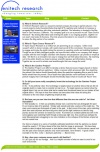Enitechlabs.com
From SarahConnor
(Difference between revisions)
| Revision as of 03:34, 15 January 2008 (edit) Thebruce (Talk | contribs) ← Previous diff |
Revision as of 16:43, 15 January 2008 (edit) (undo) Thebruce (Talk | contribs) m Next diff → |
||
| Line 2: | Line 2: | ||
| = EniTech Research Labs - EniTech.com = | = EniTech Research Labs - EniTech.com = | ||
| - | ==== As of January 14, 2008 ==== | + | === As of January 14, 2008 === |
| {| cellspacing="3" | {| cellspacing="3" | ||
| |- | |- | ||
| Line 14: | Line 14: | ||
| |} | |} | ||
| - | ===== Home ===== | + | ==== Home ==== |
| - | * The left column includes links to | + | : ([http://enitechlabs.com/index.html direct link]) |
| - | *# [[EniTech-blog-20080112|2nd Gardner Project Video - Test Results]] | + | * Includes a sidebar index [[#Sidebar|template]] linking to recent blog entries |
| - | *# [[EniTech-blog-20080106|First Public Video from the Gardner Project]] | + | * Intro paragraphs: |
| - | * also the intro paragraphs | + | |
| {|class="quote" | {|class="quote" | ||
| | | | | ||
| Line 26: | Line 25: | ||
| |} | |} | ||
| - | ===== Team ===== | + | ==== Team ==== |
| - | * Same sidebar as above | + | : ([http://enitechlabs.com/team.html direct link]) |
| + | * Includes a sidebar index [[#Sidebar|template]] linking to recent blog entries | ||
| * Bio entries for: | * Bio entries for: | ||
| *: [[Frank Bentley|Dr. Frank Bentley]] | *: [[Frank Bentley|Dr. Frank Bentley]] | ||
| Line 35: | Line 35: | ||
| *: [[Kevin Altair]] | *: [[Kevin Altair]] | ||
| - | ===== Blog ===== | + | ==== Blog ==== |
| + | : ([http://enitechlabs.com/blog direct link]) | ||
| * The EniTech Blog uses Wordpress for the backend | * The EniTech Blog uses Wordpress for the backend | ||
| * Blog entries: | * Blog entries: | ||
| Line 57: | Line 58: | ||
| ** [[EniTech-Blog-20070615|June 15, 2007 - Great paper from Spectel a few years ago...]] | ** [[EniTech-Blog-20070615|June 15, 2007 - Great paper from Spectel a few years ago...]] | ||
| - | ===== FAQ ===== | + | ==== FAQ ==== |
| - | * Same sidebar as the homepage | + | : ([http://enitechlabs.com/faq.html direct link]) |
| + | * Includes a sidebar index [[#Sidebar|template]] linking to recent blog entries | ||
| * A list of frequently asked questions | * A list of frequently asked questions | ||
| {| class="quote" | {| class="quote" | ||
| Line 83: | Line 85: | ||
| |} | |} | ||
| - | ===== Contact ===== | + | ==== Contact ==== |
| - | * Same standard as the homepage | + | : ([http://enitechlabs.com/contact.html direct link]) |
| + | * Includes a sidebar index [[#Sidebar|template]] linking to recent blog entries | ||
| * Contact information | * Contact information | ||
| {| class="quote" | {| class="quote" | ||
| Line 90: | Line 93: | ||
| :Enitech Research is always looking to hear from the community about their ideas for our research. Our open source research method is an innovative new way to change how we think about discovery. By reaching out to the public directly we hope to pioneer scientific openess and information sharing. Together we can work to achieve new breakthroughs that can change the world. | :Enitech Research is always looking to hear from the community about their ideas for our research. Our open source research method is an innovative new way to change how we think about discovery. By reaching out to the public directly we hope to pioneer scientific openess and information sharing. Together we can work to achieve new breakthroughs that can change the world. | ||
| :<br> | :<br> | ||
| - | :Please send all suggestions, ideas, and questions to feedback@enitechlabs.com. | + | :Please send all suggestions, ideas, and questions to [[feedback@enitechlabs.com]]. |
| :<br> | :<br> | ||
| :We look forward to hearing from you! | :We look forward to hearing from you! | ||
| |} | |} | ||
| + | |||
| + | ==== Sidebar ==== | ||
| + | * The left column found on various pages includes links to | ||
| + | *# [[EniTech-blog-20080112|2nd Gardner Project Video - Test Results]] | ||
| + | *# [[EniTech-blog-20080106|First Public Video from the Gardner Project]] | ||
Revision as of 16:43, 15 January 2008
EniTech Research Labs - EniTech.com
As of January 14, 2008
Home
| Team
| Blog
| FAQ
| Contact
|
Home
- Includes a sidebar index template linking to recent blog entries
- Intro paragraphs:
|
Team
- Includes a sidebar index template linking to recent blog entries
- Bio entries for:
Blog
- The EniTech Blog uses Wordpress for the backend
- Blog entries:
- Jan 14, 2008 - Anna is worried about the future
- Jan 12, 2008 - 2nd Gardner Project Video - Test Results
- Jan 11, 2008 - r 390 A/B: Downtown San Francisco - a disturbing discovery
- Jan 10, 2008 - s34A/B gives us a very unexpected result.
- Jan 10, 2008 - The Cyberdyne Tragedy, 16 years later.
- Jan 10, 2008 - Speaking of tachyon research...
- Jan 9, 2008 - The suggestions on what we should create an image of with the Gardner Project device.
- Jan 9, 2008 - Update coming shortly...
- Jan 6, 2008 - First Public Video from the Gardner Project
- Jan 3, 2008 - Images 57 A/B.
- Jan 3, 2008 - Where do the 2008 presidential candidates stands on science issues?
- Dec 24, 2007 - Image 284 A/B - 12/24/07
- Dec 23, 2007 - Image 113 A/B from this evening.
- Nov 20, 2007 - MIT Open Source Research Community
- Oct 11, 2007 - A limerick
- Sept 12, 2007 - What's in a project name?
- Aug 28, 2007 - I started a group.
- June 15, 2007 - Great paper from Spectel a few years ago...
FAQ
- Includes a sidebar index template linking to recent blog entries
- A list of frequently asked questions
|
Contact
- Includes a sidebar index template linking to recent blog entries
- Contact information
|
Sidebar
- The left column found on various pages includes links to
